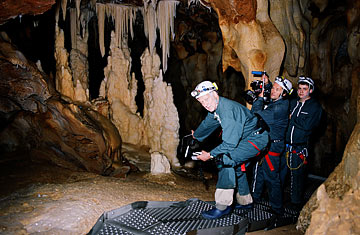
Like many an adventurer-reporter before him — like H.M. Stanley searching Africa for Dr. Livingstone, or today's brave, reckless photojournalists risking their lives in war zones — Werner Herzog loves a scoop. Less a muckraker than a dreamtaker, the German director often finds his unique stories in the lives of obsessive questers like himself: the blind-deaf woman in his 1971 Land of Silence and Darkness, who taught those similarly incapacitated how to communicate; or the scientist determined to fly an airship over the Amazonian rainforest in the 2004 The White Diamond; or The Grizzly Man (2005), who believed he could live with wild Alaskan bears and was mauled to death in the attempt. All are kindred spirits to the daredevil director. "I don't choose my subjects," he told S.T. VanAirsdale of Movieline. "They somehow come at me. Like the burglars in the night."
A pioneer who makes films about pioneers, Herzog naturally felt simpatico with the first human beings known to have painted on a wall. When he read Judith Thurman's 2008 New Yorker story about a cave discovered in the South of France in 1994 by a three-man team led by Jean-Marie Chauvet, which held drawings nearly 32,000 years old — twice as old as those in Lascaux — he resolved to make a film of them, though photography was forbidden as a safeguard to the fragile environment. He went to French Minister of Culture Frédéric Mitterand and volunteered to become a government employee for the salary of one euro (on which, Herzog promised, he would pay taxes).
Eventually, he and his three-man crew received permission to shoot for five four-hour days, with lightweight 3-D equipment, inside the Chauvet cave, under the sponsorship of The History Channel. The result, Land of Forgotten Dreams, is an enthralled and mostly enthralling guided tour of what Herzog describes as "one of the greatest art discoveries in the history of human culture."
The Lascaux caves had to be closed because the breath of the visitors was forming lichens, fungus and mold on the walls. The curators of Chauvet, which had been perfectly preserved because an avalanche had sealed it some 20,000 years ago, would admit no such corruption. The slim entrance is protected by what looks like a bank-vault door, which even Fast Five's Dom and Brian would be advised not to test. And once inside this football-field-size expanse, the few scientists allowed to visit are restricted to a narrow boardwalk, giving Herzog's team little room to maneuver. Oh, and no smoking, please.
What's all the hubbub about? A glimpse into the spirit of a time when the last Neanderthals were trudging across Europe, when the land was covered with ice, and that one could walk from Paris to London; the English Channel was a dry bed. In this late-Paleolithic age, some people entered the cave and covered one wall with what look like red dots. A closer inspection reveals them to be palm prints, a pre-literate expression of the visitors' identity, and the earliest known examples of graffiti tagging. On another wall, the print of a boy's foot is seen next to that of a wolf's paw, and Herzog wonders: "Did the wolf stalk the boy? Or did they walk together as friends? Or were their prints made thousands of years apart? We'll never know."
